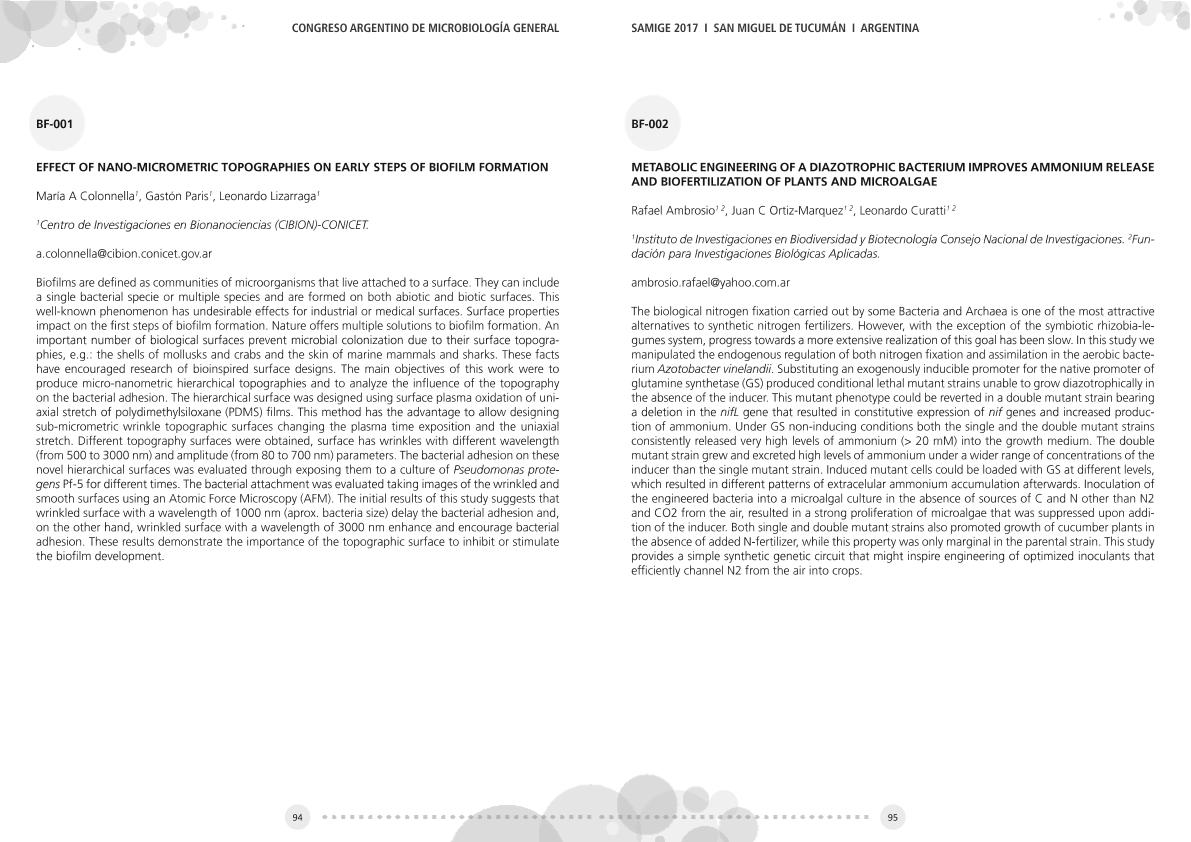Mostrar el registro sencillo del ítem
dc.contributor.author
Colonnella, Maria Antonela

dc.contributor.author
Paris, Gastón

dc.contributor.author
Lizarraga, Leonardo

dc.date.available
2023-05-02T10:30:19Z
dc.date.issued
2020
dc.identifier.citation
Effect of nano-micrometric topographies on early steps of biofilm formation; XII Congreso Argentino de Microbiología General; Tucumán; Argentina; 2017; 1-1
dc.identifier.uri
http://hdl.handle.net/11336/195891
dc.description.abstract
Biofilms are defined as communities of microorganisms that live attached to a surface. They can include a single bacterial specie or multiple species and are formed on both abiotic and biotic surfaces. Thiswell-known phenomenon has undesirable effects for industrial or medical surfaces. Surface properties impact on the first steps of biofilm formation. Nature offers multiple solutions to biofilm formation. Animportant number of biological surfaces prevent microbial colonization due to their surface topographies, e.g.: the shells of mollusks and crabs and the skin of marine mammals and sharks. These facts have encouraged research of bioinspired surface designs. The main objectives of this work were to produce micro-nanometric hierarchical topographies and to analyze the influence of the topography on the bacterial adhesion. The hierarchical surface was designed using surface plasma oxidation of uni-axial stretch of polydimethylsiloxane (PDMS) films. This method has the advantage to allow designing sub-micrometric wrinkle topographic surfaces changing the plasma time exposition and the uniaxial stretch. Different topography surfaces were obtained, surface has wrinkles with different wavelength (from 500 to 3000 nm) and amplitude (from 80 to 700 nm) parameters. The bacterial adhesion on these novel hierarchical surfaces was evaluated through exposing them to a culture of Pseudomonas protegens Pf-5 for different times. The bacterial attachment was evaluated taking images of the wrinkled and smooth surfaces using an Atomic Force Microscopy (AFM). The initial results of this study suggests thatwrinkled surface with a wavelength of 1000 nm (aprox. bacteria size) delay the bacterial adhesion and, on the other hand, wrinkled surface with a wavelength of 3000 nm enhance and encourage bacterial adhesion. These results demonstrate the importance of the topographic surface to inhibit or stimulatethe biofilm development.
dc.format
application/pdf
dc.language.iso
eng
dc.publisher
Sociedad Argentina de Microbiología General
dc.rights
info:eu-repo/semantics/openAccess
dc.rights.uri
https://creativecommons.org/licenses/by-nc-sa/2.5/ar/
dc.subject
Biofilm
dc.subject
Pseudomonas protegens
dc.subject
Nanostructures
dc.subject
AFM
dc.subject.classification
Biología Celular, Microbiología

dc.subject.classification
Ciencias Biológicas

dc.subject.classification
CIENCIAS NATURALES Y EXACTAS

dc.title
Effect of nano-micrometric topographies on early steps of biofilm formation
dc.type
info:eu-repo/semantics/publishedVersion
dc.type
info:eu-repo/semantics/conferenceObject
dc.type
info:ar-repo/semantics/documento de conferencia
dc.date.updated
2022-11-09T19:41:33Z
dc.journal.pagination
1-1
dc.journal.pais
Argentina

dc.journal.ciudad
Tucumán
dc.description.fil
Fil: Colonnella, Maria Antonela. Consejo Nacional de Investigaciones Científicas y Técnicas. Oficina de Coordinación Administrativa Parque Centenario. Centro de Investigaciones en Bionanociencias "Elizabeth Jares Erijman"; Argentina
dc.description.fil
Fil: Paris, Gastón. Consejo Nacional de Investigaciones Científicas y Técnicas. Oficina de Coordinación Administrativa Parque Centenario. Centro de Investigaciones en Bionanociencias "Elizabeth Jares Erijman"; Argentina
dc.description.fil
Fil: Lizarraga, Leonardo. Consejo Nacional de Investigaciones Científicas y Técnicas. Oficina de Coordinación Administrativa Parque Centenario. Centro de Investigaciones en Bionanociencias "Elizabeth Jares Erijman"; Argentina
dc.relation.alternativeid
info:eu-repo/semantics/altIdentifier/url/http://www.samige.org.ar/admin/news/files/108-Libro%20SAMIGE%202017.pdf
dc.conicet.rol
Autor

dc.conicet.rol
Autor

dc.conicet.rol
Autor

dc.coverage
Nacional
dc.type.subtype
Congreso
dc.description.nombreEvento
XII Congreso Argentino de Microbiología General
dc.date.evento
2017-08-02
dc.description.ciudadEvento
Tucumán
dc.description.paisEvento
Argentina

dc.type.publicacion
Book
dc.description.institucionOrganizadora
Sociedad Argentina de Microbiología General
dc.source.libro
Libro de resúmenes: XII Congreso Argentino de Microbiología General
dc.date.eventoHasta
2017-08-04
dc.type
Congreso
Archivos asociados
